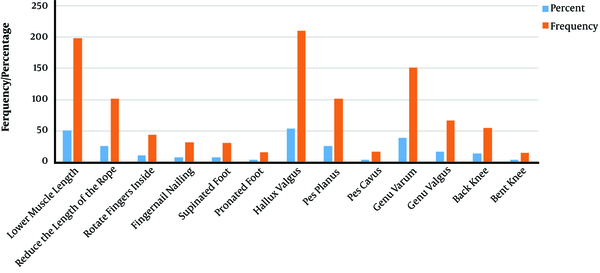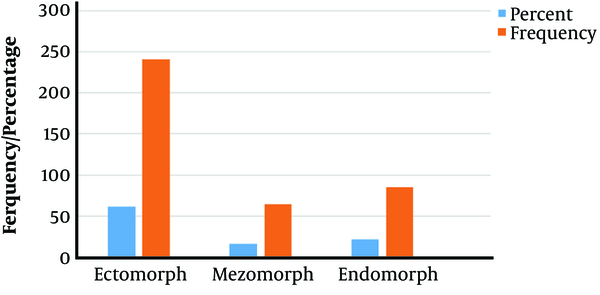1. Background
Motion is among the signs and forms of human life and its continuation brings about the growth of living beings. Motion starts from the very beginning of the formation of the sperm in humans and is the primary necessity of the development of all aspects of the physical and mental aspects of human beings. The prohibition of human beings from movement will result in many physical and mental consequences and aftermath (1, 2).
Nowadays, physical activity and having a good level of physical fitness are suggested for all age groups. In recent years, with the increase in the general welfare level in most countries, the age range of occurrence of cardiovascular and musculoskeletal disorders has declined dramatically (3). In several reports, World Health Organization (WHO) has reported the need to increase the level of physical fitness, especially in childhood, adolescence and youth (3).
One of the most significant issues attracting the attention of the therapists and specialists nowadays is the issue of physical and mental disorders in the organs and limbs of the body (1, 2). Among the most significant disorders in the lower limb are high arched foot, flat foot, knock knees, genu varum, knee flexion, hallux valgus, supinated leg, pronated legs, varus toe, ingrown nail and muscle length shortening.
The consequences of improper body status are so extensive that they can be examined in physical, psychological, economic and social dimensions. A person with weak body is in fact not in a good position for energy consumption and doing exercise. The right and proper state strengthens the sense of health in human, along which comes the ability to stand for long, the pleasure from doing movements, activities, and skills (4).
In a natural and good condition, the value of the unusual forces on the joint, minimal breathing and energy consumption are minimized, giving the person a beautiful appearance, increased self-confidence, improved motor capabilities, and a sense of satisfaction and vitality. On the contrary, poor and improper body status, besides giving a bad body appearance, lead to disruption in other body organisms, such as breathing, circulation and nervous system, in addition to giving it an unpleasant appearance, whose first complication is pain (5).
Any deviation from desirable physical condition leads to neurological disorders and unpleasant pathological damage to neuromuscular and musculoskeletal systems due to not only abnormal physical stature, but also the negative effect on muscle performance and the development of more musculoskeletal disorders (6). Overall, the causes of skeletal abnormalities are congenital and genetic disorders, some diseases and injuries, lack of physical activity, improper postural patterns in standing up, sitting, lifting and carrying heavy objects, body type, age and physical conditions, lack of growth stimulus, psychological conditions and cultural and educational problems (7). Moreover, the studies have indicated that physical abnormalities lead to functional impairment (8).
Inattention to the weaknesses and disabilities of the organs and structural defects that occur during childhood and adolescence often end in irreparable impairment in the later stages of a person’s life, disrupting the normal functioning of the body that may even reduce the longevity of the individual (9, 10).
2. Objectives
Given these important facts, the researcher attempted to examine the prevalence of lower limb abnormalities among male lower-secondary education students in Kermanshah.
3. Methods
The study was descriptive-survey conducted in cross-sectional method. The study was an attempt to identify people with abnormalities in the lower limbs using standard instruments and tests and record the information obtained as tables and charts. The population of the study was male students of lower-secondary education in Kermanshah.
The sample was 390 people who were selected from the three regions of Kermanshah using random cluster sampling. To select the students from three districts, given the total population-34305 students and their dispersion in the three districts (10285 students in districts one, 9634 students in District 2 and 14386 students in districts 3)-the researcher decided to select four schools randomly from District 1, four schools from District 2 and five schools from District 3 and randomly select 30 students in each school equally from every grade.
In order to collect information, first, students in the first, second and third grades were selected randomly in equal numbers. Then the questionnaires of general information and some individual characteristics were distributed among them. While answering questions by students, they were fully explained. After answering and completing the health self-declaration questionnaire, the purpose of the study was described to the subjects.
Then each subject went to the physical examination site. First, the height and weight of the subject were recorded in special sheets. After that, the values of the subjects were collected through caliper, pedometer, and New York test. The body type was determined using Sheldon method and descriptive statistics were used for data analysis.
4. Results
Table 1 presents the descriptive information about height, weight and age of the samples. Table 2 indicates the frequency and percentage of the students with abnormal and normal lower limbs.
| Descriptive Information | Mean ± SD |
|---|---|
| Height, cm | 150.01 ± 6.6 |
| Weight, kg | 40.78 ± 3.05 |
| Age, y | 13.7 ± 0.5 |
Mean and Standard Deviation (SD) of Height, Weight and Age of the Subjects
| Place | Normality, Frequency (%) | Abnormality, Frequency (%) |
|---|---|---|
| Lower limb | 74 (18.97) | 316 (81.03) |
Frequency and Percentage of Normality and Abnormality Observed
The frequency and percentage of students suffering from physical abnormalities are presented in Figure 1 and the student’s physical types are shown in Figure 2.
5. Discussion
The purpose of the study was to determine the level of lower limb abnormalities among male lower-secondary education students in Kermanshah. The significant point in the study was that only 18.93% of the students had normal condition, whereas 81.7% of them had abnormalities in their lower limbs. Knee flexion with 3.85% and supinated leg with 4.1% had the lowest and hallux valgus and genu varum with 53.85% and 38.72%, respectively, had the highest prevalence. Regarding body types, 61.8% of the students had ectomorph, 21.79% endomorph, and 16.41% mesomorph body types.
All normal subjects (74 subjects) had a mesomorph body type. However, there were also mesomorphs who were abnormal. The researcher sees the reasons for it to be too much use of specific muscles, exercise with the dominant side, and so on. What is significant here is that thin and fat people (ectomorphs and endomorphs) could not be natural people.
Supinated leg occurs in Subtalar Joint where the ankle rotates inside (11), and the rate of difference in the navicular height of the subjects in this abnormality is more than 10 mm (12). Factors such as spasm or shortening of fibularis brevis muscles and weakness of soleus and gastrocnemius muscles, tibialis anterior muscle, flexor pollicis longus muscle, and plantaris muscles are present in this abnormality, leading to flattening of internal longitudinal foot arch and tensile strength increase on the lower limb (13). In this abnormality, there is the weakness of the external rotator muscles (14), which causes supinated leg.
Hallux valgus is one of the most common lower limb deformities (15). It is important to consider the risk factors for hallux valgus to prevent it, as hallux valgus combines with disturbances in balance and walking and increases the risk of falling (16).
Genu varum is a common knee joint abnormality. In the normal state on the frontal plate, the center line of the center of gravity or the mechanical axis passes through the knee joint, so that the body weight is divided equally between the inner and outer parts of the knee (17). This abnormality changes the forces applied to the knee (18), so that the gravity pulling direction moves to the inside of the knee and the compressive forces increase in the interior of the knee. This difference may increase the weight loss inequality, causing postural abnormalities (19) and changing the postural control strategy while standing (20). Thus, as genu varum, caused by the impregnation momentum in the ankle and foot joint, affects postural control (21) and given the high prevalence of this complication in the present study (38.72%), the need to pay attention to the development of correctional exercises in schools has been highlighted more than ever before.
Additionally, most of the samples (81.07%) had at least one skeletal abnormality that is probably due to factors such as inheritance, everyday bad habits, non-standard equipment as well as lack of participation in regular exercise activities. Paying close attention to providing the necessary context for correction of abnormalities seems essential. This physical inactivity can cause muscle weakness and problems in the muscular structure of students, causing a negative effect on their personal and social life (22). Any disorder and disability in the musculoskeletal system, bones and joints can be a reason for feeling uncomfortable and can even cause depression and inadequate daily activities (23).
Considering the high prevalence of hallux valgus among the population, one can reflect the lack of attention of students and their parents to the standards for choosing shoes.
Furthermore, one of the reasons for the high prevalence rate of different limb abnormalities is the organ involvement. An organ with larger joints and more mobility is more vulnerable than other organs, and in contrast an organ with lower motor range by more muscles, strong ligaments, and even a bone form has a more strength (8). Genu varum with 38.7% suggests this due to the involvement of the knee joint, which is the largest subcutaneous joint.
On the other hand, the shortness of the broad muscle, which is so common among the students, has not led to a predominantly cross-sectional knee abnormality in the sample. This shows that the incidence of this complication is not just due to the shortness of the muscle. It may also be associated with functional problems and knee joint problems at an older age.
On the other hand, low rates of prevalence of supinated leg and knee flexion and similar abnormalities, which are the main cause of their congenital disorders, can be justified due to the low volume of the mother’s uterus during pregnancy, which is involved in them. According to Cote et al. supinated leg can cause a weakness in the balance of the individual. They examined the effect of the amount of front rotation less than or equal to 7 degrees on the static equilibrium using an AMTI actuator plate in open and closed conditions, and showed that the balance in a group with an aperture of more than 7 degrees was weaker than the other group (23).
Shortness of muscle and contraction of their opposite muscles are the cause of abnormalities. Thus, if the muscles have adequate flexibility, the efficiency of the different organs increases and the prevalence of complications and abnormalities are minimized (8). However, in the age range from 12 to 15, due to the longitudinal growth of the long bones, flexion and elasticity of the muscles are reduced. Hence, the researcher considers the shortness of muscles as natural in this study. If we consider it as an abnormal factor, the research should be done in a different age range.
5.1. Conclusions
Regardless of the cause and severity of abnormalities, one can state that the prevalence of abnormalities among male lower-secondary education students in Kermanshah is worrisome. However, these figures, in turn, are lower in some of the other societies collected by the researchers in some of the abnormalities and this difference can be the result of differences between the studied populations in terms of occupation, gender, age range, and so on. Thus, in this age range, one should not expect the high prevalence of abnormalities. Therefore, it is clear that educational authorities should make every effort to identify and eliminate these problems.

